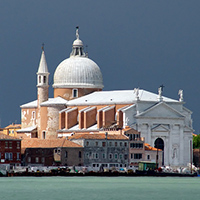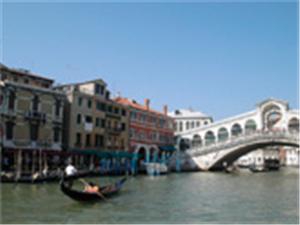
|
Piazza San Marco is the only piazza in Venice; all the other squares are named “Campo”. Piazza San Marco hosts Venice’s main attractions, Palazzo Ducale and the San Marco Basilica. Opposite the Palazzo Ducale, a small square was created where two tall columns coming from Constantinople were placed. A winged lion – the symbol of Venice – was placed on one column, and a statue of San Teodoro, the old patron saint of Venice, replaced by San Marco, on the other column. Other beautiful sights in Piazza San Marco are 'il Campanile', a tower that offers magnificent views, 'Torre dell'Orologio' and more. Basilica of San Marco was built in 829 to contain the remains of Saint Mark, the city’s patron saint. It is one of the best-known examples of Byzantine architecture and is most certainly the most spectacular church in the city.
Its main façade is unique. It has five arched doorways, a long terrace that is home to four bronze horses plundered from the 4th crusade of the infidels.
|
Its bas-relief work is in Byzantine style. The interior is just as sumptuous as the outside. The marble floor has a striking geometric pattern and there are splendid mosaics on the walls imagining scenes from the New Testament. Due to all this, the building received the nickname 'Chiesa d'Oro' (Golden Church).
San Marco Bell Tower was built in the 9th century. It was originally used as a lookout tower and a lighthouse and was rebuilt in the last century. The tower is square, built in brick; it is 12m wide and 98.6m high and is closed on top with a pyramid-shaped point. On top, there is a golden angel about 2m high. The bells were tolled to inform the city’s inhabitants of all main events organized in Venice.
Palazzo Ducale (Doge's Palace) used to be the private residence of the Doge and the Government’s and the Courts’ main offices. This exceptional building was the center of Venice’s political, social and economic life right from the beginning. There is some proof that the original building dates back to the first half of the 9th century, but it experienced important changes during time. Inside the palace, the walls are covered in wonderful frescoes narrating the history of the Republic. Among the artists who depicted these frescoes are Tiepolo, Tiziano, Veronese, Bassano and Palma il Giovane.
The “Procuratie” and the Napoleonic wing. Piazza San Marco is bordered on the right and left sides by the 'Procuratie', which are connected by the Napoleonic Wing. There are now several shops under the porticoes, the famous Café Florian and Café Quadri and there are also some luxurious Venetian jewelers such as Nardi and Missaglia. The third side of the square, the Napoleonic Wing, was built in 1807 in Neo-classical style, on Napoleon’s wish. The Napoleonic Wing now houses the Correr Museum collection. |

|
Correr Museumis located in the Napoleonic Wing of Piazza San Marco and in a part of the 'Procuratie'. It houses art, documents, artifacts, and maps that chart the history and daily life of Venice across the century and a lovely collection of sculptures by Antonio Canova. The part of the museum that is in the new 'Procuratie' hosts an exhibition showing various aspects of the city: you may observe the Serenissima trading and the traditional Venetian festivals.
Torre dell’Orologio (the Clock Tower) is also located on the side of the old Procuratie. The tower is topped by a terrace where there is a large bell and two bronze statues known as the “Mori”. The clock face is gold and blue enamel and shows the time, the lunar phases, and the zodiac signs.
The Bridge of Sighs (Ponte dei Sospiri)
This is one of the most popular tourist sights in Venice. The bridge connects the Palazzo Ducale, where prisoners were tried, to the prisons known as the Piombi. The bridge was made in stone brought from Istria and decorated on the outside with Baroque patterns.
The Mercerie cut the old city center into two parts, connecting Piazza San Marco to Rialto. This is Venice’s main throughway, the heart of the city commercial trade since ancient times when the precious fabric shops would stay open till late. The Mercerie are divided into three parts: Mercerie dell’orologio (which starts from Piazza San Marco), Mercerie de San Zulian and Mercerie di San Salvador, which come out right on Campo San Salvador, next to Campo San Bortolo. All the Mercerie are full of shops and boutiques of all kinds: from luxury jewelers, such as Cartier and Rolex, to fashion boutiques, such as Sergio Rossi for shoes and Krizia for clothes.
Scala Contarini known as “del Bovolo” is situated near Campo San Bortolo and was built around the 17th century. It received this strange name due to its peculiar spiral shape reminding of a snail, which in Venetian dialect is 'Bovolo'. The staircase winds up Palazzo Contarini facade and is seen as a high cylindrical tower from where you get a charming view of Venice’ rooftops.
Ghetto
In 1516, all Jews were forced to live in one area, the 'Getto Novo', which was surrounded by water. The ghetto was cramped and forced the Jews to build upwards and led to some of the first skyscrapers some being 7-floor tall. Now a Jewish Museum and three Synagogues are built here.
 |
Grand Canal
Venice's famous main street is one the busiest canals in the world. It snakes along 3.5 km and is lined by some of the most historical and beautiful architecture, with no less than 100 Palazzi standing guard over this waterway.
Murano
Here is the place where glass and crystal are being transformed into beautiful objects. The crystal museum called Museo Vetrario displays some beautiful glass pieces. Most tourists get to see some glass blowing displays, at least one of the factories and the showrooms are full of glassware and crystal that is for sale. The best transport to Murano is the Vaporetto (numbers 5 or 13) from Riva degli Schiavoni. |
Torcello
A contrast to the other parts of Venice, an island with monuments and older buildings many of which date to the period 7th – 13th century. Venice's first cathedral, Cattedrala di Santa Maria Assunta was built on the island in the 7th century.